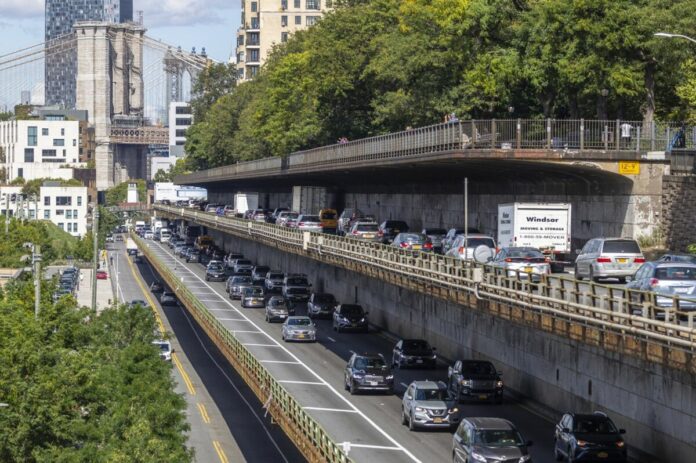
New York City is releasing a new plan to fix a deteriorating stretch of the Brooklyn-Queens Expressway, which carries 130,000 cars and trucks per day but is in such poor shape that sensors weigh trucks crossing the deck in real time to prevent heavy vehicles from collapsing the highway.
The plan is the latest development in a nearly 20-year saga that has highlighted the political and financial obstacles to building and repairing major infrastructure, even when a majority of stakeholders agree it’s needed.
The city’s plan would replace a less-than-half-mile portion of the 75-year-old BQE that hugs the East River south of the Brooklyn Bridge. Known as the “triple cantilever,” it stacks two decks on top of each other, both suspended above street level, and is crowned by a pedestrian promenade.
Designed to carry the smaller, lighter vehicles of the mid-20th century, the cantilevered roadway has been taking on the weight of heavier traffic for too long. Engineers and city officials have long warned that it will need to be closed to trucks — or all traffic, permanently — if it’s not repaired soon.
“It’s in the intensive care unit,” said Sam Schwartz, a transportation consultant who served as New York City’s traffic commissioner in the 1980s. “It’s that bad. It’s like a very slow-motion explosion.”
Decades of road salt have widened cracks in the structure and reinforcing bars inside the concrete have corroded visibly, reducing the road’s ability to flex when heavy trucks pound on it, said Schwartz. He compared the BQE’s current state to that of Franklin D. Roosevelt Drive in Manhattan in 1989, when a 500-pound slab of concrete fell to the traffic below and killed a driver.
The city’s new plan would maintain the current two-deck setup, with one two-lane deck for eastbound traffic and the other for westbound. The roadbed would be 20% wider, but the highway’s footprint would nevertheless be slimmer because the decks would be stacked directly atop one another rather than offset.
The construction work would have to negotiate a dense tangle of existing infrastructure packed into a tight area, including sewer lines and subway equipment, said Meera Joshi, New York’s deputy mayor for operations. For example, a conduit room in a fan plant that provides ventilation for the subway will have to be moved. City officials said the Department of Transportation is working with the Metropolitan Transit Authority to figure out a way forward.
The cost is estimated at around $5 billion. And it’s not yet clear where the money will come from.
The city’s application for $800 million in US Department of Transportation funding to rehab this part of the BQE was denied earlier this year; instead the city says funding for the project would come from a blend of city tax dollars, federal formula grant money, and discretionary grants. The NYC Department of Transportation also has $1.7 billion in its capital plan that could be put toward the new expressway.
The plan must also go through a public comment period and a thorough environmental analysis — all of which means ground couldn’t be broken until mid-2029 at the earliest.
That date is a serious concern: Nearly 10 years ago, consultants had told the Department of Transportation that if the structure wasn’t repaired by 2026, it might need to add more weight restrictions and banish trucks. “I’d say it’s a very high probability that there will be an emergency event on the triple cantilever before 2029,” Schwartz said. “It could be a hole through the deck. It could be concrete that falls below. But I’d say it’s a high probability.”
Thursday’s announcement opens a new chapter in the troubled story of the Brooklyn-Queens Expressway, most of which was constructed in the 1940s and ’50s as part of parks commissioner Robert Moses’s car-oriented development crusade, displacing tens of thousands of residents and destroying homes and businesses on its 12-mile course between the boroughs.
But the cantilevered structure causing today’s engineering problems was born out of compromise. After seeing plans for the BQE slicing through well-to-do Brooklyn Heights, homeowners banded together to push the city to reroute it closer to the waterfront, creating the popular pedestrian promenade in the process.
The concession was a rare example of the famed master builder changing his plans in response to community pushback, says New York architect Adam Paul Susaneck, who has chronicled the damage wrought by that era’s urban highways in his project Segregation By Design and in a new documentary that focuses on the history of the BQE. Similar pleas from neighborhoods like Red Hook and Cobble Hill, home to many immigrants and Black residents, weren’t given the same hearing at the time.
The cantilevered arrangement of stacked roadways, designed by landscape architects Michael Rapuano and Gilmore Clarke, gave the city a much-beloved walkway, but left the city with an ongoing maintenance headache. Figuring out what to do with the aging artery has preoccupied architects, transportation planners and city officials for years, and this new plan is just the latest in a parade of proposals.
In 2018, the city proposed two unpopular ideas to rebuild the crumbling cantilevers — one of which would have temporarily diverted the highway onto the pedestrian promenade during construction, and both of which would have cost up to $4 billion. That year, architecture firm Bjarke Ingels Group also released renderings for a more boundary-breaking project called the BQP, or Brooklyn-Queens Park, which would push car traffic down to grade level and transform all three levels of the cantilever with green space. None of the plans have moved forward.
In 2020, the city council mulled a $11 billion proposal that would have torn down the cantilever entirely and replaced it with a tunnel under downtown Brooklyn; meanwhile, former comptroller Scott Stringer pushed a plan that would have replaced one of the levels with an elevated park, and limited another to truck traffic.
The urgency of the current situation shouldn’t prevent the city from thinking expansively, said Lauren Mayer, the communications manager for the Congress for the New Urbanism, an advocacy group that has called for the removal of several urban highways across the US. “It needs repairs. And that doesn’t just mean business as usual,” said Mayer, who hadn’t reviewed the city’s new plan. “That means repairs in the form of reparative work — and that might mean removal, road diets, all that kind of stuff as well.”
The BQE in 2020.Photograph: Lokman Vural Elibol/Anadolu Agency via Getty Images
Several groups have pushed a broader reimagining of the entire BQE corridor. Many of the neighborhoods most affected by the pollution and noise from the roadway are lower-income communities of color; the fact that the city is prioritizing this half-mile strip that adjoins an affluent stretch of Brooklyn when the harms of the BQE extend much further has frustrated some environmental justice activists.
In South Williamsburg, for example, a proposal called the BQGreen that was first pitched in 2010 still has the support of many locals. It would cap the expressway and connect two adjacent parks, adding green space and mitigating some of the pollution that has made the neighborhood’s asthma rates among the worst in the city. “We had what was our federal, state, city representatives advocating for this at the time — but the funding wasn’t being prioritized,” said Diana Reyna, a former New York City Council member and deputy Brooklyn borough president who originally spearheaded the BQGreen. Now out of city government, she’s still working to ensure that any plan for the cantilever comes with investment in her community, too.
A group of Cobble Hill residents have also proposed capping what they call the BQE’s “noxious, fume-spewing open trench” with public green space, while the Institute for Public Architecture has convened designers to investigate “the possibility of removing it in total or in part.”
“It’s not just about removing lanes or removing the highway — it’s about what you bring in, as well, to make those areas reconnected,” said CNU’s Mayer.
Retaining the existing expressway’s layout also represents something of a step backwards from other city-led efforts to reduce vehicle emissions and truck traffic, from the “Blue Highways” initiative, which seeks to build up maritime shipping options, to the recent authorization of e-cargo bikes for delivery on city streets.
Most prominently, the city’s BQE announcement comes just weeks after New York Governor Kathy Hochul surprised the city by halting a long-planned congestion pricing policy intended to reduce emissions and raise revenue for transit improvements by charging drivers of private vehicles to enter parts of Manhattan. According to a 2019 Regional Plan Association report, congestion tolls could have trimmed traffic on the overburdened BQE by 13% — potentially extending its safe lifespan and delivering other options for future reconfiguration.
Joshi conceded that rebuilding this segment of the BQE doubles down on vehicle traffic. But the BQE isn’t just a commuter mover — it’s also a freight corridor, used by about 13,000 trucks each day. Finding alternatives for them is trickier than diverting people into buses or subways, and could include investing in regional modes that use the rivers and rails.
“Congestion and car traffic is our reality,” Joshi said. “We have to be realistic about the fact that all of the traffic and trucks in New York City will not disappear overnight.”
(c) Bloomberg












Let’s set up a toll on it. They like taxing everything
Just tax us to death and that will take care of all problems facing New Yorkers. At least on our death bed we can say, we gave every penny we had to our beloved City. Croak.
The accident he refers to in 1989 that killed one driver- was a Frumme Yid. Rabbi Binyamin Bernstien : https://www.jstor.org/stable/20685221
They need to stop with the useless “public comments” and “environmental studies”. They could’ve rebuilt the entire Gowanus and BQE from the Verrazano to the Triboro twice over by now.